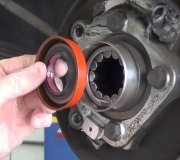Introduction
The differential in your vehicle plays a crucial role in transferring power to the wheels while allowing them to rotate at different speeds. To ensure smooth operation and longevity, maintaining the correct differential gear oil level is essential. Rear wheel drive and some front wheel drive cars and trucks use gear oil or differential fluid to lubricate the gears and bearings of the differential.
This fluid is heavy weighted oil, (90w or 80w) and can be synthetic or conventional style grades which is capable of maintaining lubrication under extreme loads, which can be checked by inspecting by removing the fill plug which is covered in the guide below.
Tools and Materials Needed
- Car jack and jack stands (or a vehicle lift)
- Wheel chocks
- Gloves and safety glasses
- Shop towel
- Wrench or socket set (typically 3/8-inch or 1/2-inch drive for the fill plug)
- Flashlight
- Gear oil (if needed for a top-up)
- Fluid pump (optional, for refilling)
- WD40 (optional)
Before you begin park the vehicle on level ground, in park, and the parking brake set. The car will need be raised up and secured with jack stands, also wear protective eyewear and gloves.
1. Locate Oil Fill Plug
The oil fill plug is usually located on the front part of the differential near the pinion gear flange, on the rear cover, or on the side of the case. It is a good idea to spray WD40 on the plug threads and allow it to sit, then use an appropriate tool to remove the fill port plug.
2. Check the Gear Oil Level
Using a small wire or your little finger insert it downward into the hole to feel for the fluid, once removed the fluid should be present, and if not the fluid level is low, if the level correct will be just below the level of the plug hole, (If gear oil drips out, it is full and you can reinsert and tighten the plug).
(Safety Note: Do not turn drive shaft or rear wheels while checking the gear oil level because the gears inside the unit.)
3. Prepare Gear Oil
Gear oil usually is purchased in quarts, its a good idea to purchase an inexpensive pump to make the job easier like in the image below. Use the correct type of gear oil specified in your vehicle’s manual.
4. Add Gear Oil
Insert the tube into the fill port and continue adding fluid until it spills out from the service port. This is what it will look like once you have enough gear oil inside the differential, reinsert the fill plug by hand to avoid cross threading, finish by tightening the plug. Clean the excess gear oil from differential using a shop towel.
Conclusion
When inspecting the differential look for wetness around both axle seals and the pinion gear seal. Also, check for leaks around the gear cover which is in indication the gear oil level might be low. A differential will start to make a humming sound at higher speeds when the oil level has dropped below the required level.
If the differential is equipped with a locking carrier, it will have a tag informing of a special fluid or additive that must be used. Perform a differential service on a regular basis to ensure the proper operation. Knowing how a differential works aids in troubleshooting noise related problems.
Watch the Video!
Please watch this video of the job being done to glean additional helpful information.
Credits
This guide knowledge base was created by the 2CarPros Team, and by Ken Lavacot: Automobile repair shop owner and certified master automobile technician of over 30 years. If you have question or need help please ask one of our experts we are happy to help. Please visit our 2CarPros YouTube Channel.







